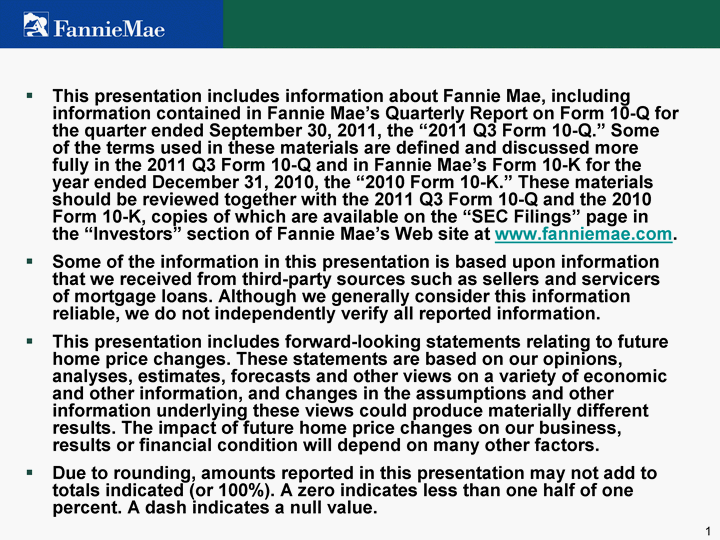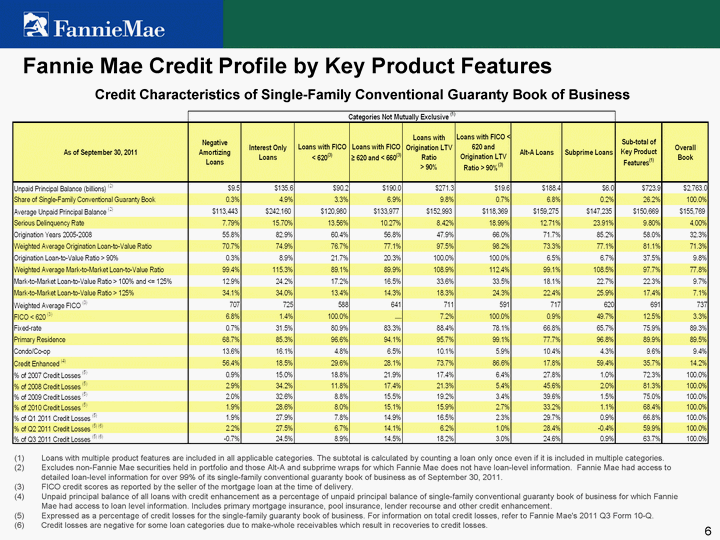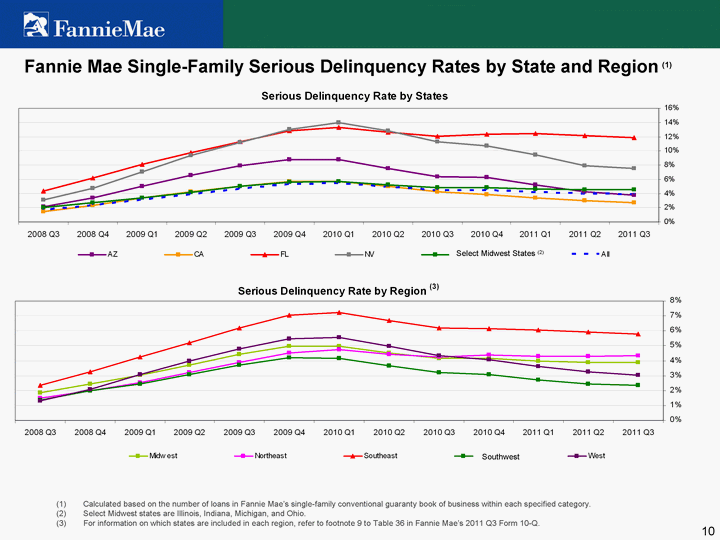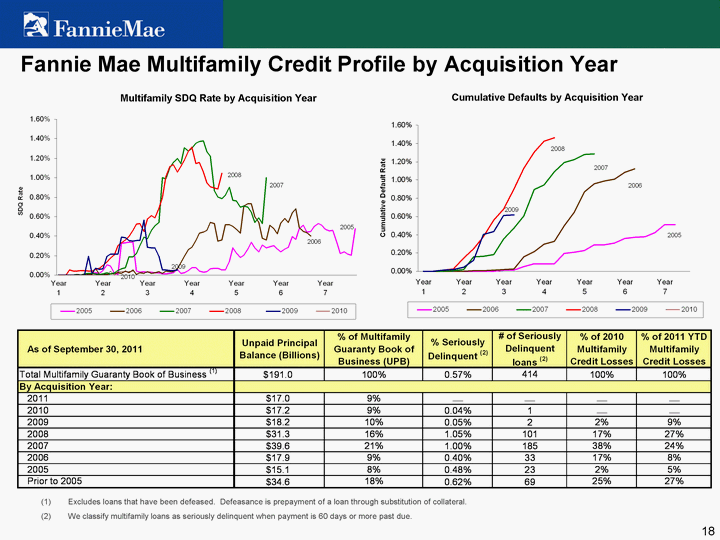Attached files
| file | filename |
|---|---|
| 8-K - 8-K - FEDERAL NATIONAL MORTGAGE ASSOCIATION FANNIE MAE | w84608e8vk.htm |
| EX-99.1 - EX-99.1 - FEDERAL NATIONAL MORTGAGE ASSOCIATION FANNIE MAE | w84608exv99w1.htm |
Exhibit 99.2

| November 8, 2011 Fannie Mae 2011 Third-Quarter Credit Supplement |

| This presentation includes information about Fannie Mae, including information contained in Fannie Mae's Quarterly Report on Form 10-Q for the quarter ended September 30, 2011, the "2011 Q3 Form 10-Q." Some of the terms used in these materials are defined and discussed more fully in the 2011 Q3 Form 10-Q and in Fannie Mae's Form 10-K for the year ended December 31, 2010, the "2010 Form 10-K." These materials should be reviewed together with the 2011 Q3 Form 10-Q and the 2010 Form 10-K, copies of which are available on the "SEC Filings" page in the "Investors" section of Fannie Mae's Web site at www.fanniemae.com. Some of the information in this presentation is based upon information that we received from third-party sources such as sellers and servicers of mortgage loans. Although we generally consider this information reliable, we do not independently verify all reported information. This presentation includes forward-looking statements relating to future home price changes. These statements are based on our opinions, analyses, estimates, forecasts and other views on a variety of economic and other information, and changes in the assumptions and other information underlying these views could produce materially different results. The impact of future home price changes on our business, results or financial condition will depend on many other factors. Due to rounding, amounts reported in this presentation may not add to totals indicated (or 100%). A zero indicates less than one half of one percent. A dash indicates a null value. |

| Table of Contents Slide Home Price Growth/Decline Rates in the U.S. 3 Home Price Change Peak-to-Current as of 2011 Q3 4 Fannie Mae Acquisition Profile by Key Product Features 5 Fannie Mae Credit Profile by Key Product Features 6 Fannie Mae Credit Profile by Origination Year and Key Product Features 7 Fannie Mae Credit Profile by State 8 Fannie Mae Alt-A Credit Profile by Key Product Features 9 Fannie Mae Single-Family Serious Delinquency Rates by State and Region 10 Fannie Mae Single-Family Completed Workouts by Type 11 Home Affordable Modification Program (HAMP) 12 Fannie Mae Single-Family Loan Modifications by Monthly Payment Change and Type 13 Performance of Fannie Mae Modified Loans 14 Fannie Mae Single-Family Cumulative Default Rates 15 Fannie Mae Single-Family Real Estate Owned (REO) in Selected States 16 Fannie Mae Multifamily Credit Profile by Loan Attributes 17 Fannie Mae Multifamily Credit Profile by Acquisition Year 18 Fannie Mae Multifamily Credit Profile 19 Fannie Mae Multifamily 2011 YTD Credit Losses by State 20 |

| Home Price Growth/Decline Rates in the U.S. Note: Our estimates differ from the S&P/Case-Shiller index in two principal ways: (1) our estimates weight expectations by number of properties, whereas the S&P/Case-Shiller index weights expectations based on property value, causing home price declines on higher priced homes to have a greater effect on the overall result; and (2) the S&P/Case-Shiller index includes sales of foreclosed homes while our estimates attempt to exclude foreclosed homes sales, because we believe that differing maintenance practices and the forced nature of the sales make foreclosed home prices less representative of market values. We believe, however, that the impact of sales of foreclosed homes is reflected in our estimates as a result of their impact on the pricing of non-distressed sales. We recently enhanced our home price estimates to identify and exclude a greater portion of foreclosed home sales. As a result, some period to period comparisons of home prices differ from those indicated by our prior estimates. We calculate the S&P/Case-Shiller comparison numbers by modifying our internal home price estimates to account for weighting based on property value and the impact of foreclosed property sales. In addition to these differences, our estimates are based on our own internally available data combined with publicly available data, and are therefore based on data collected nationwide, whereas the S&P/Case-Shiller index is based on publicly available data, which may be limited in certain geographic areas of the country. Our comparative calculations to the S&P/Case-Shiller index provided above are not modified to account for this data pool difference. S&P/Case-Shiller Index 9.8% 7.7% 10.6% 10.7% 14.6% 14.7% -0.3% -8.4% -18.4% -2.4% -3.7% -0.6** Fannie Mae Home Price Index Growth rates are from period-end to period-end. We expect peak-to-trough declines in home prices to be in the 22% to 28% range (comparable to a decline in the 32% to 40% range using the S&P/Case-Shiller index method). *Year-to-date as of Q3 2011. Initial estimate based on purchase transactions in Fannie-Freddie acquisition and public deed data available through the end of September 2011, supplemented by preliminary data available for October and November 2011. Including subsequent data may lead to materially different results. ** Year-to-date as of Q2 2011. |

| Top %: State/Region Home Price Decline Rate percentage from applicable peak in that state/region through September 30, 2011. Bottom %: Percent of Fannie Mae single-family conventional guaranty book of business by unpaid principal balance as of September 30, 2011. Note: Regional home price decline percentages are a housing stock unit-weighted average of home price decline percentages of states within each region. * Source: Fannie Mae. Initial estimate based on purchase transactions in Fannie-Freddie acquisition and public deed data available through the end of September 2011, supplemented by preliminary data available for October and November 2011. Including subsequent data may lead to materially different results. Home Price Change Peak-to-Current as of 2011 Q3* |

| Fannie Mae Acquisition Profile by Key Product Features Credit Characteristics of Single-Family Business Volume (1) Percentage calculated based on unpaid principal balance of loans at time of acquisition. Single-family business volume refers to both single-family mortgage loans we purchased for our mortgage portfolio and single-family mortgage loans we guaranty into Fannie Mae MBS. Beginning with the third quarter of 2011, we prospectively report loans underlying long- term standby commitments in the period in which the commitment was established, rather than at the time of actual delivery. The increase for 2010 and 2011 is the result of our Refi PlusTM initiative, which involves the refinance of existing Fannie Mae loans with loan-to-value ratios up to 125%. Refi Plus and Home Affordable Refinance Program (HARP) started in April 2009. FICO credit scores as reported by the seller of the mortgage loan at the time of delivery. Newly originated Alt-A loans acquired in 2009, 2010, and 2011 consist of the refinance of existing Alt-A loans under our Refi Plus initiative. |

| Fannie Mae Credit Profile by Key Product Features Credit Characteristics of Single-Family Conventional Guaranty Book of Business Loans with multiple product features are included in all applicable categories. The subtotal is calculated by counting a loan only once even if it is included in multiple categories. Excludes non-Fannie Mae securities held in portfolio and those Alt-A and subprime wraps for which Fannie Mae does not have loan-level information. Fannie Mae had access to detailed loan-level information for over 99% of its single-family conventional guaranty book of business as of September 30, 2011. FICO credit scores as reported by the seller of the mortgage loan at the time of delivery. Unpaid principal balance of all loans with credit enhancement as a percentage of unpaid principal balance of single-family conventional guaranty book of business for which Fannie Mae had access to loan level information. Includes primary mortgage insurance, pool insurance, lender recourse and other credit enhancement. Expressed as a percentage of credit losses for the single-family guaranty book of business. For information on total credit losses, refer to Fannie Mae's 2011 Q3 Form 10-Q. Credit losses are negative for some loan categories due to make-whole receivables which result in recoveries to credit losses. |

| Fannie Mae Credit Profile by Origination Year and Key Product Features Credit Characteristics of Single-Family Conventional Guaranty Book of Business by Origination Year Excludes non-Fannie Mae securities held in portfolio and those Alt-A and subprime wraps for which Fannie Mae does not have loan-level information. Fannie Mae had access to detailed loan- level information for over 99% of its single-family conventional guaranty book of business as of September 30, 2011. The increase for 2010 and 2011 is the result of our Refi Plus loans, which started in April 2009, and involve the refinance of existing Fannie Mae loans with loan-to-value ratios up to 125%. FICO credit scores as reported by the seller of the mortgage loan at the time of delivery. Unpaid principal balance of all loans with credit enhancement as a percentage of unpaid principal balance of single-family conventional guaranty book of business for which Fannie Mae has access to loan-level information. Includes primary mortgage insurance, pool insurance, lender recourse and other credit enhancement. Expressed as a percentage of credit losses for the single-family guaranty book of business. For information on total credit losses, refer to Fannie Mae's 2011 Q3 Form 10-Q. Defaults include loan liquidations other than through voluntary pay-off or repurchase by lenders and include loan foreclosures, preforeclosure sales, sales to third parties and deeds in lieu of foreclosure. Cumulative Default Rate is the total number of single-family conventional loans in the guaranty book of business originated in the identified year that have defaulted, divided by the total number of single-family conventional loans in the guaranty book of business originated in the identified year. For 2000 to 2004 cumulative default rates, refer to slide 15. |

| Fannie Mae Credit Profile by State Credit Characteristics of Single-Family Conventional Guaranty Book of Business by State Excludes non-Fannie Mae securities held in portfolio and those Alt-A and subprime wraps for which Fannie Mae does not have loan-level information. Fannie Mae had access to detailed loan-level information for over 99% of its single-family conventional guaranty book of business as of September 30, 2011. FICO credit scores as reported by the seller of the mortgage loan at the time of delivery. Unpaid principal balance of all loans with credit enhancement as a percentage of unpaid principal balance of single-family conventional guaranty book of business for which Fannie Mae has access to loan-level information. Includes primary mortgage insurance, pool insurance, lender recourse and other credit enhancement. Expressed as a percentage of credit losses for the single-family guaranty book of business. For information on total credit losses, refer to Fannie Mae's 2011 Q3 Form 10-Q. Select Midwest states are Illinois, Indiana, Michigan and Ohio. |

| Fannie Mae Alt-A Credit Profile by Key Product Features Credit Characteristics of Alt-A Single-Family Conventional Guaranty Book of Business by Origination Year "Alt-A mortgage loan" generally refers to a mortgage loan that can be underwritten with reduced or alternative documentation than that required for a full documentation mortgage loan but may also include other alternative product features. In reporting our Alt-A exposure, we have classified mortgage loans as Alt-A if the lenders that deliver the mortgage loans to us have classified the loans as Alt-A based on documentation or other product features. We have classified private-label mortgage-related securities held in our investment portfolio as Alt-A if the securities were labeled as such when issued. Newly originated Alt-A loans acquired in 2009, 2010, and 2011 consist of the refinance of Alt-A existing loans under our Refi Plus initiative. Excludes non-Fannie Mae securities held in portfolio and those Alt-A and subprime wraps for which Fannie Mae does not have loan-level information. Fannie Mae had access to detailed loan-level information for over 99% of its single-family conventional guaranty book of business as of September 30, 2011. The increase for 2009, 2010, and 2011 is the result of Refi Plus loans, which started in April 2009 and can have loan-to-value ratios up to 125%. FICO credit scores as reported by the seller of the mortgage loan at the time of delivery. Defined as unpaid principal balance of Alt-A loans with credit enhancement as a percentage of unpaid principal balance of all Alt-A loans. At September 30, 2011, 10.0% of unpaid principal balance of Alt-A loans carried only primary mortgage insurance (no deductible), 6.1% had only pool insurance (which is generally subject to a deductible), 1.2% had primary mortgage insurance and pool insurance, and 0.4% carried other credit enhancement such as lender recourse. Expressed as a percentage of credit losses for the single-family guaranty book of business. For information on total credit losses, refer to Fannie Mae's 2011 Q3 Form 10-Q. Q3 credit losses are negative (gain) for some loan categories due to a change in our estimates relating to make whole receivables. The increase in make whole receivables resulted in recoveries to credit losses. Defaults include loan liquidations other than through voluntary pay-off or repurchase by lenders and includes loan foreclosures, preforeclosure sales, sales to third parties and deeds in lieu of foreclosure. Cumulative Default Rate is the total number of single-family conventional loans in the guaranty book of business originated in the identified year that have defaulted, divided by the total number of single-family conventional loans in the guaranty book of business originated in the identified year. |

| Fannie Mae Single-Family Serious Delinquency Rates by State and Region (1) Calculated based on the number of loans in Fannie Mae's single-family conventional guaranty book of business within each specified category. Select Midwest states are Illinois, Indiana, Michigan, and Ohio. For information on which states are included in each region, refer to footnote 9 to Table 36 in Fannie Mae's 2011 Q3 Form 10-Q. Select Midwest States (2) Southwest |

| Fannie Mae Single-Family Completed Workouts by Type Modifications involve changes to the original mortgage loan terms, which may include a change to the product type, interest rate, amortization term, maturity date and/or unpaid principal balance. Modifications include completed modifications made under the Administration's Home Affordable Modification Program (HAMP), which was implemented in March 2009, but do not reflect loans currently in trial modifications. Information on Fannie Mae loans under the Home Affordable Modification Program is provided on Slide 12. Repayment plans involve plans to repay past due principal and interest over a reasonable period of time through temporarily higher monthly payments. Loans with completed repayment plans are included for loans that were at least 60 days delinquent at initiation. Forbearances involve an agreement to suspend or reduce borrower payments for a period of time. Loans with forbearance plans are included for loans that were at least 90 days delinquent at initiation. Deeds in lieu of foreclosure involve the borrower's voluntarily signing over title to the property. In a preforeclosure sale, the borrower, working with the servicer, sells the home prior to foreclosure to pay off all or part of the outstanding loan, accrued interest and other expenses from the sale proceeds. HomeSaver Advance TM are unsecured, personal loans designed to help qualified borrowers bring their delinquent mortgage loans current after a temporary financial difficulty. The Program was retired on September 30, 2010. TM |

| Provides immediate payment relief to borrowers who are delinquent or in imminent risk of payment default. We require servicers to first evaluate all Fannie Mae problem loans for HAMP eligibility. If a borrower is not eligible for HAMP, our servicers are required to exhaust all other workout alternatives before proceeding to foreclosure. Home Affordable Modification Program (HAMP) Data Source: United States Treasury Department as reported by servicers to the system of record for the Home Affordable Modification Program. Fannie Mae Loans Under HAMP Active Permanent HAMP modifications exclude modifications on loans that subsequently canceled because the loans were 90+ days delinquent or have paid off. Re-performance rates for modified single-family loans, including permanent HAMP modifications, are presented on Slide 14. |

| Fannie Mae Single-Family Loan Modifications by Monthly Payment Change and Type Change in Monthly Principal and Interest Payment of Modified Single-Family Loans(1)(2) Excludes loans that were classified as subprime adjustable rate mortgages that were modified into fixed rate mortgages and were current at the time of modification. Modifications include permanent modifications, but do not reflect loans currently in trial modifications. Represents the change in the monthly principal and interest payment at the effective date of the modification. The monthly principal and interest payment on modified loans may vary, and may increase, during the remaining life of the loan. Modification Type of Single-Family Loans(1)(2) |

| Performance of Fannie Mae Modified Loans Re-performance Rates of Modified Single-Family Loans(1) Excludes loans that were classified as subprime adjustable rate mortgages that were modified into fixed rate mortgages and were current at the time of modification. Modifications include permanent modifications, but do not reflect loans currently in trial modifications. Includes loans that are paid off. |

| Note: Defaults include loan liquidations other than through voluntary pay-off or repurchase by lenders and include loan foreclosures, preforeclosure sales, sales to third parties and deeds in lieu of foreclosure. Cumulative Default Rate is the total number of single-family conventional loans in the guaranty book of business originated in the identified year that have defaulted, divided by the total number of single-family conventional loans in the guaranty book of business originated in the identified year. Data as of September 30, 2011 are not necessarily indicative of the ultimate performance of the loans and performance is likely to change, perhaps materially, in future periods. Fannie Mae Single-Family Cumulative Default Rates Cumulative Default Rates of Single-Family Conventional Guaranty Book of Business by Origination Year |

| Select Midwest states are Illinois, Indiana, Michigan, and Ohio. Fannie Mae Single-Family Real Estate Owned (REO) in Selected States |

| Fannie Mae Multifamily Credit Profile by Loan Attributes Excludes loans that have been defeased. Defeasance is prepayment of a loan through substitution of collateral. We classify multifamily loans as seriously delinquent when payment is 60 days or more past due. Weighted Average Original loan-to-value ratio is 66% as of September 30, 2011. Under the Delegated Underwriting and Servicing, or DUS (r), product line, Fannie Mae purchases individual, newly originated mortgages from specially approved DUS lenders using DUS underwriting standards and/or DUS loan documents. Because DUS lenders generally share the risk of loss with Fannie Mae, they are able to originate, underwrite, close and service most loans without our pre-review. Multifamily loans under $3 million and up to $5 million in high income areas. |

| Fannie Mae Multifamily Credit Profile by Acquisition Year Excludes loans that have been defeased. Defeasance is prepayment of a loan through substitution of collateral. We classify multifamily loans as seriously delinquent when payment is 60 days or more past due. Cumulative Defaults by Acquisition Year Multifamily SDQ Rate by Acquisition Year |

| Fannie Mae Multifamily Credit Profile Excludes loans that have been defeased. Defeasance is prepayment of a loan through substitution of collateral. We classify multifamily loans as seriously delinquent when payment is 60 days or more past due. For information on which states are included in each region, refer to Fannie Mae's 2011 Q3 Form 10-Q. Asset Class Definitions: Conventional/Co-Op Housing: Privately owned multifamily properties or multifamily properties in which the residents collectively own the property through their shares in the cooperative corporation. Seniors Housing: Multifamily rental properties for senior citizens. Manufactured Housing: A residential real estate development consisting of housing sites for manufactured homes, related amenities, utility services, landscaping, roads and other infrastructure. Student Housing: Multifamily rental properties in which 80% or more of the units are leased to undergraduate and/or graduate students. The Multifamily Affordable Business Channel focuses on financing properties which are under a regulatory agreement that provides long-term affordability, such as properties with rent subsidies or income restrictions. |

| Fannie Mae Multifamily 2011 YTD Credit Losses by State ($ Millions) Numbers: Represent 2011 YTD credit losses for each state which total $298M(2) as of September 30, 2011. States with no numbers had less than $1 million in credit losses in YTD 2011. Shading: Represent Unpaid Principal Balance (UPB) for each state. These amounts total $191 billion as of September 30, 2011. Excludes loans that have been defeased. Defeasance is prepayment of a loan through substitution of collateral. Excludes $19M of credit related income from other Multifamily Mortgage Business investments. Example: UPB in Michigan is $2.7B and 2011 YTD Credit Losses have been $6M Portfolio UPB(1) Concentration by State as of 09/30/2011 |
